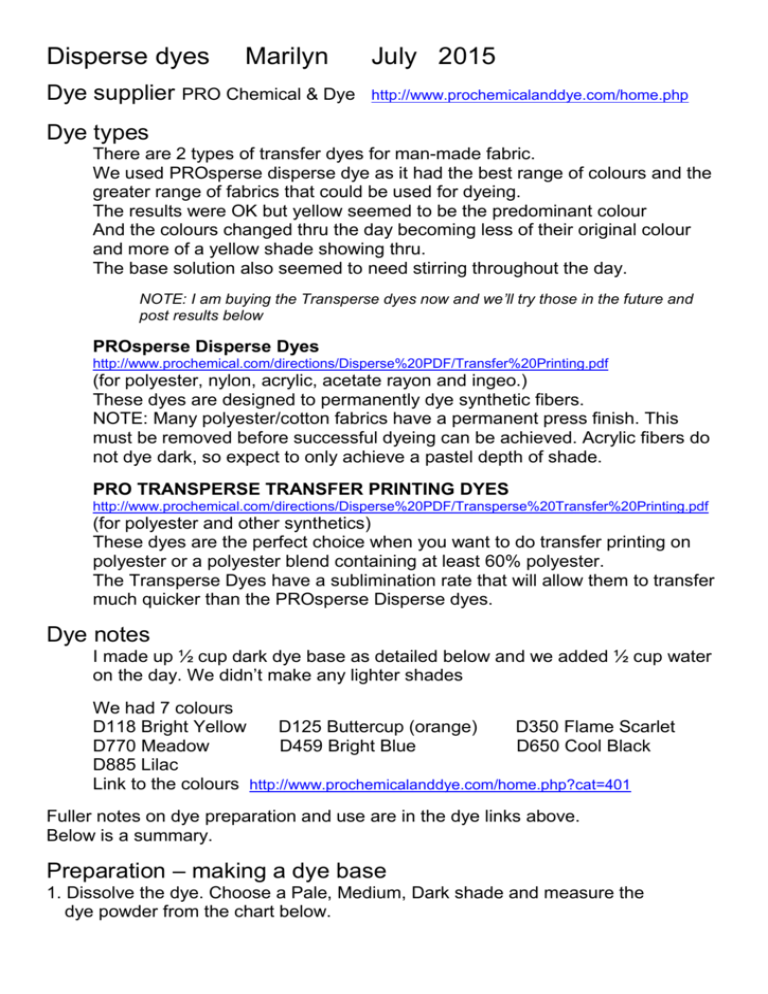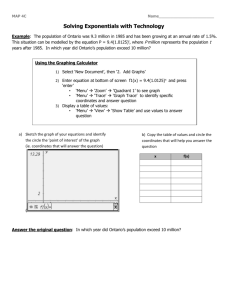Dissolved dye 1/2 cup (125 ml)
advertisement

Disperse dyes Marilyn Dye supplier PRO Chemical & Dye July 2015 http://www.prochemicalanddye.com/home.php Dye types There are 2 types of transfer dyes for man-made fabric. We used PROsperse disperse dye as it had the best range of colours and the greater range of fabrics that could be used for dyeing. The results were OK but yellow seemed to be the predominant colour And the colours changed thru the day becoming less of their original colour and more of a yellow shade showing thru. The base solution also seemed to need stirring throughout the day. NOTE: I am buying the Transperse dyes now and we’ll try those in the future and post results below PROsperse Disperse Dyes http://www.prochemical.com/directions/Disperse%20PDF/Transfer%20Printing.pdf (for polyester, nylon, acrylic, acetate rayon and ingeo.) These dyes are designed to permanently dye synthetic fibers. NOTE: Many polyester/cotton fabrics have a permanent press finish. This must be removed before successful dyeing can be achieved. Acrylic fibers do not dye dark, so expect to only achieve a pastel depth of shade. PRO TRANSPERSE TRANSFER PRINTING DYES http://www.prochemical.com/directions/Disperse%20PDF/Transperse%20Transfer%20Printing.pdf (for polyester and other synthetics) These dyes are the perfect choice when you want to do transfer printing on polyester or a polyester blend containing at least 60% polyester. The Transperse Dyes have a sublimination rate that will allow them to transfer much quicker than the PROsperse Disperse dyes. Dye notes I made up ½ cup dark dye base as detailed below and we added ½ cup water on the day. We didn’t make any lighter shades We had 7 colours D118 Bright Yellow D125 Buttercup (orange) D350 Flame Scarlet D770 Meadow D459 Bright Blue D650 Cool Black D885 Lilac Link to the colours http://www.prochemicalanddye.com/home.php?cat=401 Fuller notes on dye preparation and use are in the dye links above. Below is a summary. Preparation – making a dye base 1. Dissolve the dye. Choose a Pale, Medium, Dark shade and measure the dye powder from the chart below. Dissolve the dye powder with 1/2 cup (125 ml) of boiling water and stir until thoroughly mixed. Let mixture cool to room temperature and stir well again. Dye Powder Pale Medium 1/2 tsp (1.3 gm) 2 tsp (5 gm) Dark 4 tsp (10 gm) 2. Make the Dye Paint. If you are watercolor painting, add the dissolved dye and water as listed in the chart below. Dissolved dye Water Watercolor painting 1/2 cup (125 ml) 1/2 cup (125 ml) If you are screen printing, add the dissolved dye with Thin or Thick Stock Thickener Paste. The dye paint thickness described below is a guideline. Experiment until you get the thickness that works well for you. Dissolved dye Stock Thickener Paste Hand painting 1/2 cup (125 ml) 1/2 cup (125 ml) Thin Paste Screen printing 1/2 cup (125 ml) 1/2 cup (125 ml) Thick Paste To mix dye for a variety of shades: Mix a DARK base 10gm dye powder ½ cup boiling water THEN mix to a dye paint Take the ½ cup dark base and mix into ½ cup water = 1 cup DARK = ready to use or dilute to other shades For a MED shade Take the ½ cup DARK dye paint and mix into ½ cup water = 1 cup MED For a PALE shade Take the ¼ cup MED dye paint and mix into ¼ cup water = ½ cup PALE Keep adding ¼ cups water for PALER colours Tips for transfer dyeing A google search will give plenty of results for ideas and tips. http://pintangle.com/2007/05/11/how-to-use-transfer-dyes-to-print-on-synthetic-fabric/ http://juliet-rainbowsend.blogspot.co.nz/p/tutorials.html and other nylon dyeing eg buttons Basic guidelines Paint your design on computer paper (or similar type if you want bigger sheets) The colours are very subdued and dark on the paper but come alive on the fabric Paint with splotches or washes of colour or with a technique listed below Dry the dyed sheet with a hair dryer or leave to dry naturally Lay baking paper on your ironing board then your fabric then the dye sheet, face down, then another baking paper sheet. The baking paper protects the iron and board from a smear of dye colour. Even tho the dye sheets are dry the iron will pick up a slight colouring. This can work to your advantage if you are ironing a design and don’t want the starkness of the fabric showing around the edge as the smear of colour softens the background. IRON 1minute for light up to 5 mins for dark dye transfer We had some light results on the day and after contact with PRO Chemical I have added the below image and note. Image of comparison ironing Left – class dyeing Right – strips of dye paper at top and under it is Fabric ironed as below Slightly move the iron so you don’t get an “iron” shape but keep the iron in the same area so that dye heats up and then it will become a gas and dye the fabric a strong colour. The dye sheets can be used multiple times before the colour becomes too light to use. Mixed dye and dyed sheets were still strong enough to use 2 months after the class. Techniques we tried Cut a paper design, lay on fabric and iron dye sheet over the top. This gives a coloured background with the fabric colour showing the design. You can then flip the “coloured” paper design onto another piece of fabric and iron for a negative of the first piece eg the fabric colour is now the background and the colour is the design. Use doilies or lace to: Paint on and use as a pattern or paint thru for the negative pattern 1st image shows a few of the results 2nd image shows the last ironing result and the dyed doily See how the different dye colours have come thru with successive ironing and how dark the original painted doily is. Plant material can also be used for printing and a resist for a positive and negative art. Print solid dye paper on crinkled fabric. The ironed sheet shows on left of image. I then crinkled up the fabric and ironed the same sheet over the crinkles for a shattered look Previously used dye sheets were cut up and woven together before ironing Sally used black dye to paint the outline of a newspaper face. Ironing only transferred the dye not the newspaper image. Paint a background sheet and iron on fabric Paint a picture and iron over background fabric Image is by Sally - grass We quickly tried a sponge soaked with dye in a shallow tray to use as a stamp pad. It only gave light printings. It may have been because the stamp lines were very fine or the dye was a bit weak but the result was good enough to want to explore some more. Iron on different textured fabrics Images show different results of the ironed dye over stripes and leaves. Different fibres react differently to the dye Colour in clip art https://www.google.co.nz/search?q=colouring+books+for+adults+nz&espv=2&biw=1366&bih=643&site=webhp&source=lnms&tbm =isch&sa=X&ved=0CAYQ_AUoAWoVChMIyIGH9sTyxgIVJOimCh2JfgZy#tbm=isch&q=colouring+for+adults+printable&imgdii=1pM RrfISJuISzM%3A%3B1pMRrfISJuISzM%3A%3B5vM9XaUN1AKroM%3A&imgrc=1pMRrfISJuISzM%3A Use a photocopy, computer printout as a base. Colour it and iron on fabric. The clip art lines act as a resist to the dye which gives an outline. Wonder if you could draw an image with a vivid for same result? Image is art by Sue of a branch photocopy. Printing Text clip art https://www.youtube.com/watch?v=MFAVH3uu0Nw Open a word document Click on menu “insert” – top left of screen Click on “wordart” – top right of screen Choose any word (text) box as all can be formatted later Type in your text – change any font size and type etc at the top of the box / OK See the youtube video for extra formatting etc Click in text box which opens the format menu (if it isn’t still open) Click on rotate – top right of screen Click on flip horizontal Print and then paint with dye. When the paper sheet is flipped over and ironed onto another surface the text is the correct way round ==================================== Below are some clip art images to get you started. Enlarge to the size you want eg click on image and drag the corner point to required size to print out and use.





